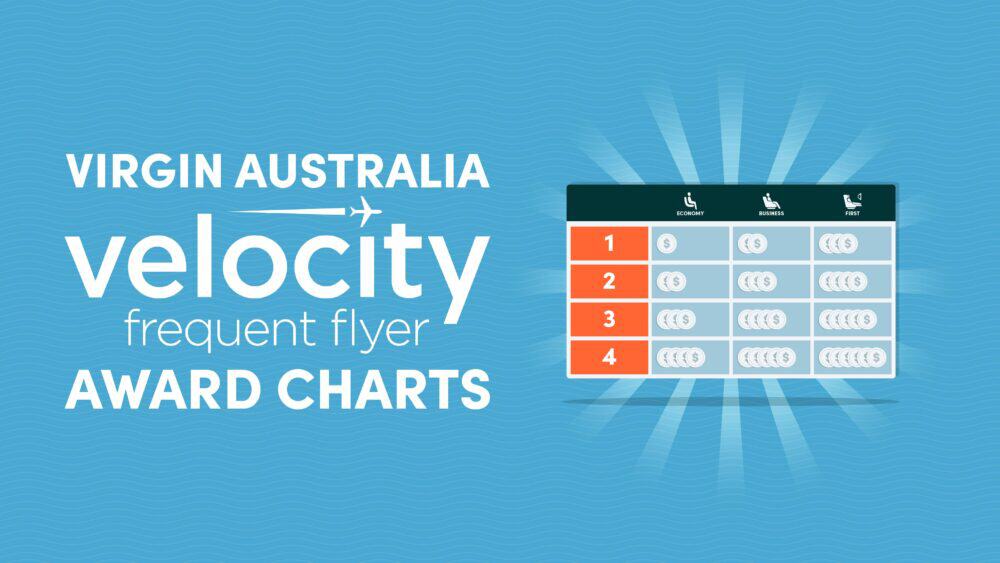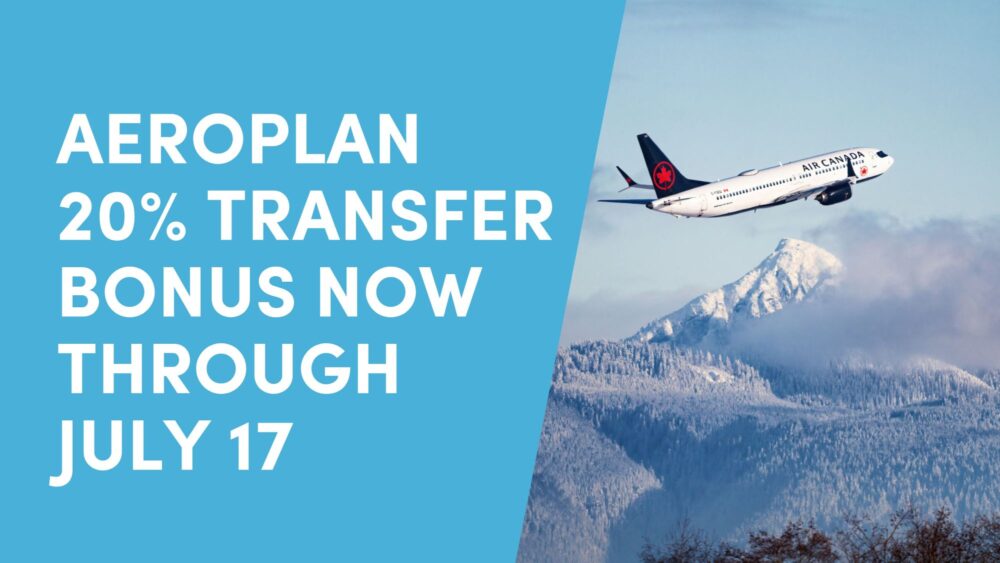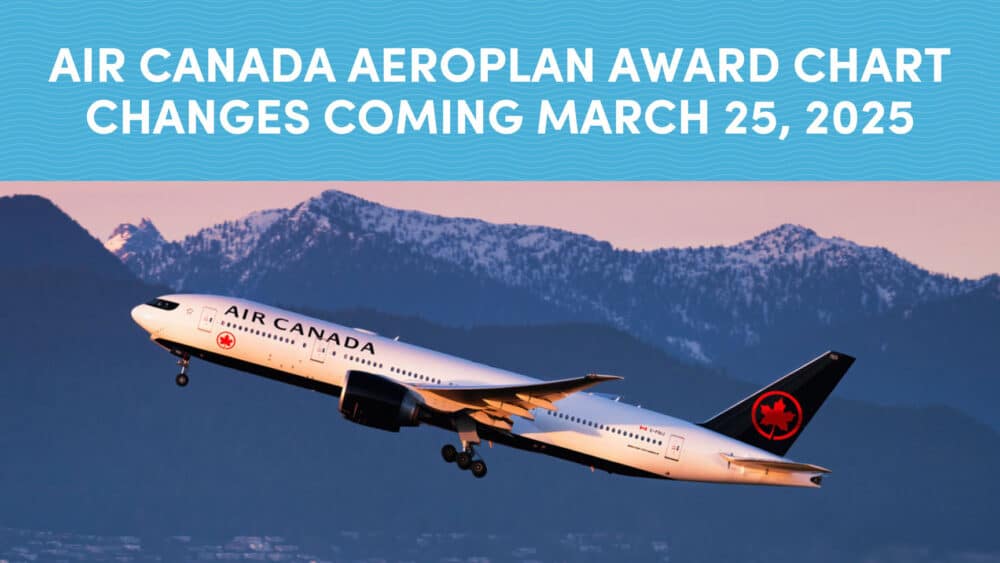
10xTravel is part of an affiliate sales network and receives compensation for sending traffic to partner sites, such as CreditCards.com. This compensation may impact how and where links appear on this site. This site does not include all financial companies or all available financial offers. Terms apply to American Express benefits and offers. Enrollment may be required for select American Express benefits and offers. Visit americanexpress.com to learn more.
Note: Some of the offers mentioned below may have changed or may no longer be available. The content on this page is accurate as of the posting date; however, some of our partner offers may have expired. You can view current offers here.
Air Canada recently implemented changes to its Aeroplan loyalty program.
When we say this is an all-new award program, we really mean it. This isn’t simply a devaluation. Aeroplan has truly created something new that we haven’t seen before.
Let’s take a deep dive into the new award chart and at some of the pros and cons of the new program.
Aeroplan’s New Award Chart
Thankfully, Aeroplan didn’t get rid of a published award chart (a more common occurrence these days). The new award chart is neither distance-based nor a zone-based, but instead is a hybrid system that uses the distance between different zones to calculate award rates.
Award rates are based on the total miles flown between two zones, not on the distance between your origin and destination. It is not priced per segment, but on the total itinerary traveled.
Pay attention to the different distance bands between zones. You’ll find that many of them start dividing up some of the bigger zones into subzones based on where you can travel in each distance band.
I’ll break down these general rules so you can get a feel for them. Keep in mind, these are general rules and there will be some exceptions.
Award Rates on Air Canada Flights vs Partner Flights
Before diving into the new award chart, it’s important to understand how the new Aeroplan program will calculate award rates. These rates will differ between Air Canada flights and their partner airlines.
For Air Canada flights, Aeroplan will use dynamic award rates. Meanwhile, partner flights will have fixed award rates. Technically, Air Canada is doing away with “Saver” level flights that they currently operate and instead will be offering any seat available on a scale.
In practice, there will still be saver level seats. These will just be seats that are available at the lowest required mileage for a given route. All seats will be available, but only a limited number of seats will require the lowest mileage. All other seats will fall into a defined range.
Sometimes, the points required for Air Canada flights will be lower than what’s required for partner flights. But, in general, the mileage requirement for partner flights is the lowest amount an Air Canada flight will cost.
Additionally, you’ll only be able to redeem points for premium economy on Air Canada flights.
The Aeroplan Hybrid Distance and Zone-Based Award Chart
To understand the new Aeroplan award chart, the first thing you need to know is that the redemption rate depends on the distance traveled between (or within) zones. The published pricing is for one-way flights between two zones over a given distance. There are four zones:
- North America
- South America
- Atlantic
- Pacific
North America includes Canada, the United States, all of Central America and the Caribbean. South America is fairly straightforward, as it is the continent of South America. The Atlantic and Pacific Regions are a bit harder to understand.

New Aeroplan Award Zones (image courtesy of Aeroplan)
The Atlantic region includes Europe, Africa, Greenland, part of Russia, the Middle East, and Asia extending over through India.
The Pacific Zone includes Australia and the Eastern part of Asia including China, Japan, Oceania, and the Southeast Asian Peninsula.
To determine the number of Aeroplan points you’ll need in the new award chart, you’ll need to refer to the relevant award chart. There are a total of 10 award charts composed of travel with a single zone and between different zones.
Within North America

For flights within North America, you can expect to need the following number of points for travel on Air Canada Flights based on the total distance flown:
- Economy: 6,000 to 22,500 points
- Premium Economy: 10,000 to 45,000 points
- Business: 15,000 to 70,000 points
For flights within North America on partner airlines, you will need the following points depending on distance traveled:
- Economy: 6,000 to 22,500 points
- Business: 15,000 to 35,000 points
The distance bands covering 0-500 miles and 501-1,500 are primarily for domestic flights or flights between nearby cities. Meanwhile, the 1,501-2,750 band covers more long-distance travel between different countries or transcontinental travel between the East and West Coast.
Finally, the 2,751+ distance band applies primarily to flights from Canada to Central America or flights between the East Coast and Hawaii.
Between North America and Atlantic Zones

For flights between North America and the Atlantic zones, you’ll need the following number of points on Air Canada Flights:
- Economy: 35,000 to 100,000 points
- Premium Economy: 50,000 to 160,000 points
- Business: 60,000 to 220,000 points
If you’re wanting to travel on a partner airline between North America and the Atlantic zones, you can expect to pay the following amount of points:
- Economy: 35,000 to 70,000 points
- Business: 60,000 to 100,000 points
- First: 90,000 to 130,000 points
Although Air Canada lists an award rate for first class on Air Canada flights, Air Canada doesn’t have first class for long international flights. Realistically, you can expect to pay between 90,000 and 130,000 points for first class on a partner airline as Air Canada doesn’t offer an international first class product. Additionally, you cannot redeem points for premium economy on partner airlines between North America and the Atlantic regions.
8,001+ miles may seem like a long way, but remember the Atlantic zone includes Africa, the Middle East, and the Indian Subcontinent as well.
8,001+ miles may seem like a long way, but remember the Atlantic zone includes Africa, the Middle East, and the Indian Subcontinent as well. Flying from the West Coast to South Africa, or from New York to India transiting through Europe are two easy ways to break into the 8,001+ mile range for travel between the North America and Atlantic zones.
Realistically, 0-4,000 miles covers flights between Eastern North America and Europe. 4,001-6,000 miles is your distance band that covers the West Coast to Europe.
The 6,001-8,000 mile zone covers travel from the East Coast to the Middle East and India, while 8,001+ zone will primarily be flights from the US West Coast to India and the Middle East, and between North America and Africa.
Between North America and Pacific Zones

For flights between North America and the Pacific Zone you can expect to spend the following number of points if you’re flying on Air Canada:
- Economy: 35,000 to 110,000 points
- Premium Economy: 45,000 to 180,000 points
- Business: 55,000 to 105,000
If you’re traveling on a partner airline, the following mileage requirements apply:
- Economy: 35,000 to 60,000 points
- Business: 55,000 to 105,000 points
- First: 90,000 to 140,000 points
Again, Air Canada does not offer first class on its international flights, so really you will only be able to book first class on partner airlines. This means first class travel between North America and the Pacific zones will cost anywhere from 90,000 to 140,000 points.
The Pacific zone includes the eastern half of Russia, China, Mongolia, Southeast Asia, North and South Korea, Japan, Oceania, Australia, and Micronesia.
Breaking these distance bands down into zones, you can get a rough estimate for the travel distances.
Traveling 0-5,000 miles mostly includes the Pacific Northwest, cities such as Seattle (SEA) and Vancouver (YVR), to Tokyo (NRT or HND).
If you’re traveling 5,001-7,500 miles, it will be for travel between California and Australia, or the West Coast to most of Asia.
For travel between 7,501 miles and 11,000 miles, which will primarily be from the East Coast to Asia or the East Coast and Australia.
Finally, 11,001+ miles only includes flights with connections. It’s currently impossible to travel more than 11,000 miles on a single flight. As of publication, the world’s longest flight is between Newark (EWR) and Singapore (SIN) at 9,534 miles.
If your trip is in the 11,001+ miles band, you’ll be making a long journey, such as traveling to Australia via Asia. New York (JFK) to Sydney (SYD) via Tokyo (NRT) comes out to 11,590 miles.
It’s pretty easy to break into the 11,001+ mile band if you’re traveling to Oceania or Australia and transiting through Asia. However, flying through Asia can open up more award options to get to Australia.
Between North America and South America

Flights between North America and South America have one of the smallest award charts in the new Aeroplan program. Below is the range of points you’ll expect to pay for travel between North and South America on Air Canada Flights:
- Economy: 30,000 to 70,000 points
- Premium Economy: 45,000 to 150,000 points
- Business: 50,000 to 200,000 points
- First: 80,000 to 250,000 points
For travel on partner airlines, the following mileage requirements apply:
- Economy: 30,000 to 40,000 points
- Business: 50,000 to 60,000 points
- First: 80,000 to 100,000 points
Neither Air Canada nor any of the partner airlines offer first class between North America and South America directly, so you can pretty much ignore that option.
Flights that run 0 to 4,500 miles will primarily be flights to Northern countries in South America – think flights to Peru and Colombia. Meanwhile, most flights to South America’s southern countries such as Brazil, Argentina, and Chile will primarily be in the 4,501+ miles distance band.
Within The Atlantic Zone

Air Canada doesn’t have any flights within the Atlantic Zone, so only partner awards are available for travel within the Atlantic Zone. Since you can’t book partner awards in premium economy, you’ll be limited only to economy, business, or first class.
- Economy: 7,500 to 50,000 points
- Business: 15,000 to 80,000 points
- First: 25,000 to 130,000 points
Many of Air Canada’s Star Alliance partners in the Atlantic region do offer first class. Keep in mind, many of the shorter flights in the Atlantic Zone will be offered in European style business or first class where it is the same standard economy seats, just with the middle seat blocked.
Flights in the 0-1,000 mile distance band will mostly be short, intra-Europe flights. Flights in the 1,001-2,000 mile range will cover more of your transcontinental flights, such as between London (LHR) and Istanbul (IST), or Madrid (MAD) and Kiev (KBP).
When you get into the 2,001-4,000 mile range, you start encountering flights between regions, such as between Europe and the Middle East, or the Middle East and Africa. 4,001-6,000 miles covers most of your flights between Europe and the Indian Subcontinent. When you get to 6,001+ miles, you’re looking mostly at connecting flights, or some very odd long routes such as flights between Greenland and South Africa (which will likely also be connecting flights).
Within The Pacific Zone

Similar to the Atlantic Zone, Air Canada doesn’t fly any flights themselves within the Pacific Zone so all award flights are operated by partner airlines. There can be some really long flights within the Pacific Zone, so there are 5 distance levels with varying mileage requirements. You will need the following amount of miles depending on the class of service and the distance you’re flying.
- Economy: 8,000 to 55,000 points
- Business: 20,000 to 90,000 points
- First: 25,000 to 130,000 points
Within the Pacific Zone, flights 0-1,000 miles will cover short domestic and international flights such as flights between Tokyo (HND) and Seoul (ICN). 1,001-2,000 miles includes similar flights with just a tad more distance. You can get around most of Asia in 1,001-2,000 mile distances such as Hong Kong (HKG) to Singapore (SIN) or Tokyo (NRT).
The 2,001-5,000 mile band helps you traverse all the way across Asia, and from Asia to Australia from most destinations. The 5,001-7,000 mile band doesn’t come into play unless you’re traveling to New Zealand from Asia, but some routes will still fall into the 2,001-5,000 mile distance band. 7,001+ miles primarily will apply to flights with connections.
Between Atlantic and Pacific Zones

The Atlantic and Pacific Zones chart may look small, but many flights will either be relatively short or relatively long flights. There are three distance bands for award travel between the Atlantic and Pacific Zones with prices ranging accordingly.
- Economy: 40,000 to 60,000 points
- Business: 60,000 to 100,000 points
- First: 80,000 to 130,000 points
Considering there are some very close international hubs, you’ll find quite a number of flights falling into the 0-5,000 mile range. Flights between India or the Middle East and virtually all of Asia will be in the 0-5,000 range.
You’ll find most flights from Western Europe to Asia fall into the 5,001-7,000 mile range. Some will be shorter, but for most they’ll be 5,001-7,000 miles long.
Crossing into the 7,001+ mile territory really begins whenever you start traveling from the Atlantic region to Australia. Flights from India and South Africa to Australia are around 6,500 miles. Once you get to the Middle East and Mainland Europe you’re already over 7,000 miles in distance.
Flights Within South America

Flights within South America are pretty straightforward. Economy flights cost 15,000 points on partner airlines, business class flights are 30,000 points, and first class flights are 50,000 points (although, again, there aren’t really any first class flights within South America).
Flights Between Atlantic and South America

Travel between the Atlantic and South America only breaks into two distance bands: 0-7,000 and 7,001+ miles. Air Canada doesn’t operate any direct flights between the Atlantic region and South America, so you can only book a partner award requiring the following amount of points:
- Economy: 45,000 to 60,000 points
- Business: 80,000 to 100,000 points
- First: 100,000 to 130,000 points
Flights in the 0-7,000 mile range will include most flights between Africa and South America, as well as flights from Europe to Northern South America. Flights between Europe and Southern South America (such as Chile and Argentina) will start pushing into the 7,001+ mile range along with flights from India and the Middle East to South America.
Flights Between Pacific and South America

Flights between the Pacific and South America zones have two distance bands: 0-11,000 miles and 11,001+ miles. The points required are as follows:
- Economy: 60,000 points to 80,000 points
- Business: 90,000 points to 140,000 points
- First: 130,000 points to 200,000 points
Stopover Rules
With the new program, Aeroplan has reconfigured its stopover rules. Previously, you could include a stopover on a round-trip ticket (similar to United’s Excursionist Perk) for no extra miles. Now, stopovers will require 5,000 additional points but you can include one on a one-way award ticket. Stopovers are not permitted in the U.S. and Canada, and are limited to a maximum of 45 days.

Booking Fees and Surcharges
There’s both some good changes and some negative changes to the taxes and fees charged by Aeroplan on award tickets.
I’ll start with the bad. The bad news is there will now be a $39CAD (approximately $30USD at the time of publishing) award booking fee for all partner bookings. It’s annoying to charge a fee to book a partner flight, but given the trade-offs you’ll soon see, I’ll take it.
The good news. The really good news. The fantastic news. Aeroplan will no longer include surcharges on any award tickets. This means award tickets on partners such as Austrian Airlines and Lufthansa – notorious for steep surcharges – will no longer have the steep cash cost.
If you have to book over the phone, which you often do for more complicated award bookings, you will also be charged a $30CAD phone booking fee. Again, worth it if it means you’re avoiding fuel surcharges. This fee should be waived if you’re booking a stopover, which currently is unavailable to be booked online.
We’ll note that Aeroplan maintains that you should be able to book all trips online, but currently there is no option to book a stopover online.
Cancellation and Change Fees
Aeroplan is also changing how they’re handling cancellations and flight changes. If you cancel or change within 24 hours of booking your award flight, you’ll be eligible for a full refund of your points and any taxes and fees paid.
Otherwise, you can cancel or change your flight up to 2 hours before departure. The cancellation and/or change fee you pay depends on the class of service you booked and the fare class of your ticket.

Family Sharing
Many airlines still require you to pay to transfer points between family members so that you have enough points in one account to book the tickets you need. There are some notable exceptions, such as British Airways, but most airlines aren’t very friendly when it comes to combining points.
Aeroplan is changing that. In the new Aeroplan award program, you can take advantage of family sharing.
With the family sharing option, up to 8 family members can pool their points and any status perks together for the purposes of booking award tickets. All points earned by each member will go into the pool and any member can redeem the points at any time.
Aeroplan Transfer Partners
Currently, you can transfer Amex Membership Rewards, Capital One miles, and Marriott Bonvoy points to Aeroplan. Membership Rewards transfer at a 1:1 ratio while Capital One miles transfer at a 2:1.5 ratio and Marriott Bonvoy points transfer 3:1.
Most people choose to transfer Membership Rewards, but having options can help you get the right amount of points you need in your account to book your award ticket.
Final Thoughts
There’s a lot to be excited about in the new Aeroplan award chart. Whether it is family pooling so you can share your miles with your loved ones or the new stopover rules, you’ll gladly find some increased value with the new Aeroplan changes.
Of course, the biggest downside of the new program is that awards rates will go up in many cases. While devaluations are never fun, it has been years since Aeroplan devalued its award chart so we can’t be too surprised to see these changes.
Be sure to study up on the new award chart, especially if you’ll be earning Amex Membership Rewards points.
New to the world of points and miles? The Chase Sapphire Preferred® Card is the best card to start with.
With a bonus of 75,000 bonus points after you spend $5,000 on purchases in the first 3 months from account opening. , 5x points on travel booked through Chase Travel℠ and 3x points on restaurants, streaming services, and online groceries (excluding Target, Walmart, and wholesale clubs), this card truly cannot be beat for getting started!
Editors Note: Opinions expressed here are author’s alone, not those of any bank, credit card issuer, hotel, airline, or other entity. This content has not been reviewed, approved or otherwise endorsed by any of the entities included within the post.









